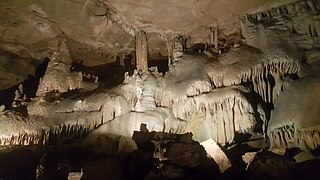Crystal Cavern(s), also known throughout the years as Alabama Caverns and McClu(n)ney Cave, is a small cavern containing crystal formations located in Clay, Alabama, USA.

Alabaster Caverns State Park is a 200-acre (0.81 km2) state park approximately 4.5 miles (7.2 km) south of Freedom, Oklahoma, United States near Oklahoma State Highway 50. The park attracted 24,706 visitors in FY 2016, The lowest count of the three parks in its part of Oklahoma. According to the Encyclopedia of Oklahoma History and Culture, the park Previously attracted about 40,000 visitors per year. It is home to the largest natural gypsum cave in the world that is open to the public. The gypsum is mostly in the form of alabaster. There are several types of alabaster found at the site, including pink, white, and the rare black alabaster. This black alabaster can be found in only three veins in the world, one each in Oklahoma, Italy and China. Another form of gypsum can be found in the many selenite crystal formations.

Scaffold web spiders (Nesticidae) is a family of araneomorph spiders closely allied with tangle web spiders. Like the "Theridiidae", these spiders have a comb of serrated bristles on the hind tarsi that are used to pull silk bands from the spinnerets. It contains 16 genera and about 300 species, many of which are associated with caves or overhangs. The genus Nesticus is the type for the family and is found throughout the world. The related Eidmannella has speciated considerably in Texas caves and includes some extremely localized species that are considered threatened. One species, Eidmannella pallida, is found in caves and under overhangs, but also in agricultural fields and other habitats away from such restricted areas. The genus Carpathonesticus is found in central Eurasia.

Lewis and Clark Caverns State Park is a 3,000-acre (1,200 ha) public recreation and nature preservation area located twelve miles (19 km) east of Whitehall in Jefferson County, Montana. The state park includes two visitor centers, ten miles of hiking trails, a campground, and its namesake limestone caverns. The Lewis and Clark Caverns Historic District was placed on the National Register of Historic Places in 2018.

Raccoon Mountain Caverns is a cave located in Chattanooga, Tennessee in a band of Mississippian Period limestone, part of the Cumberland Plateau.

Cave of the Crystals or Giant Crystal Cave is a cave connected to the Naica Mine at a depth of 300 metres (980 ft), in Naica, Chihuahua, Mexico.

Nesticus is a genus of American and Eurasian scaffold web spiders first described by Tamerlan Thorell in 1869.
Nesticus nasicus is a species of cave cobweb spider in the family Nesticidae. It is found in the United States.

Kryptonesticus is a genus of European scaffold web spiders first described by Pavlek & Ribera in 2017. All but the type species were transferred from Nesticus. With the exception of K. eremita, individual species have very restricted ranges.
Carpathonesticus borutzkyi is a species of araneomorph spider of the family Nesticidae. It occurs in Russia, Georgia, Turkey and Ukraine and is found in caves.
Domitius menozzii is an araneomorph spider species of the family Nesticidae. It occurs in Italy, where it can be found in caves. It was described by Ludovico di Caporiacco in 1934.
Carpathonesticus racovitzai is an araneomorph spider species of the family Nesticidae. It occurs in Romania, where it can be found both in caves and outdoors. It was transferred from the genus Nesticus to Carpathonesticus in 1982 by Weiss and Heimer.
Carpathonesticus spelaeus is an araneomorph spider species of the family Nesticidae. It occurs in Romania, where it can be found in caves and outdoors under calcareous blocks. It was transferred from the genus Nesticus to Carpathonesticus in 1980 by Lehtinen and Saaristo.

Grotta dell'Artiglieria is a Karst cave in the municipality of Doberdò del Lago. The cave is located NE of Doberdob Lake, near the top of a small hill, in the small village of Jamiano. The name is referred to the artillery battery set in the cave during World War I.
Nesticus barri is a species of true spider in the family Nesticidae. It is found in the United States.

Windmill Hill Cavern is a limestone cave system in the town of Brixham, Devon. It was discovered in 1858 and later excavated by a team led by the geologist William Pengelly, who found proof that humans co-existed with extinct British fauna.
Domitius beaticus is an araneomorph spider species of the family Nesticidae. It is known to occur in Spain. The species is troglobitic, occurring solely in caves.







